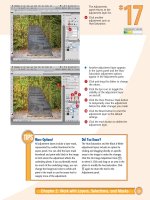HomeMade EASY~TO~MAKE THINGS FOR YOUR GARDEN ken braren
Bạn đang xem bản rút gọn của tài liệu. Xem và tải ngay bản đầy đủ của tài liệu tại đây (17.65 MB, 243 trang )
HomeMade
HomeMade
101 EASY~TO~MAKE THINGS FOR YOUR
GARDEN, HOME, OR FARM
By Ken Braren & Roger Griffith
The mission of Storey Publishing is to serve our customers by publishing
practical information that encourages personal independence in harmony
with the environment.
© 1977 by Storey Publishing, LLC
Designed, with cover, by Trezzo/Braren Studio Illustrations by Ken Braren
All rights reserved. No part of this book may be reproduced without written
permission from the publisher, except by a reviewer who may quote brief
passages or reproduce illustrations in a review with appropriate credits; nor
may any part of this book be reproduced, stored in a retrieval system, or
transmitted in any form or by any means—electronic, mechanical,
photocopying, recording, or other—without written permission from the
publisher.
The information in this book is true and complete to the best of our
knowledge. All recommendations are made without guarantee on the part of
the author or Storey Publishing. The author and publisher disclaim any
liability in connection with the use of this information. For additional
information, please contact Storey Publishing, 210 MASS MoCA Way,
North Adams, MA 01247.
Storey books are available for special premium and promotional uses
and for customized editions. For further information, please call 1-800-7939396.
Printed in the United States by Versa Press
40 39 38 37 36 35 34
Library of Congress Cataloging-in-Publication Data
Braren, Ken, 1934Homemade: 101 easy-to-make things for your garden,
house, or farm,
p. cm.
ISBN 978-0-88266-103-2
1. Building. 2. Do-it-yourself work. I. Griffith, Roger,
1919- joint author. II. Title.
TH153.B65
690′.8 77.2887
Contents
Part 1
EASY~TO~MAKE THINGS POR TOUR HOME
Sawhorse
Carpenter’s Tool Box
Workbench
Basement Closet
Potting Bench
Sandpaper Block
Brush Cleaner
Wood Stove Heater
Firewood Brace
Sawbuck
Fuel Sled
Stovewood Holder
Wood Box
Fireplace Front
Root Cellar
Window Greenhouse
Outdoor Storage Bins
Indoor Storage Bins
Tomato Ripening Unit
Solar Drier
Smokehouse
Picnic Bench
Lawn Chair
Bootjack
Mailbox Holder
Hanging Planters
Macramé Hanger
Fluorescent Light
Plant Stand
Part 2
EASY~TO~MAKE THINGS FOR YOUR GARDEN
Tool Shed
Tool Storage
Tool Sharpening
Tool Cleaner
Tool Finder
Tool Brander
Hose Storage
Handy Box
Tea, Garden Style
Compost Materials
Compost Piles
Two-Bin Composting
New Zealand Compost Box
Handy Composter
Simple Compost Bin
Cold Frames
Hotbeds
Soil Sifters
Soils Sifter
Seedling Containers
Plant Protectors
Planting Tray
Garden Layout Stakes
Berry Box
Strawberry Pyramid
Strawberry Barrel
Massive Pots
Baling Hay
Plant Supports
Tomato Supports
Garden Fences
Setting Posts
Tight Fence
Corner Posts
Electric Fence
Preserving Posts
Gates
Foot-Operated Gate
Stone Fence Gate
Gate Hinge
Gate Latches
Stiles
Turnstile
Garden Bench
Light Bench
Folding Bench
Growing Grapes 132
Grapevine Building
Birdhouse
Easy Birdhouse
Robin’s Shelf
Bird Feeders
Part 3
EASY~TO~MAKE THINGS FOR YOUR FARM
Hog House
Pig Feeder
Movable Shed
Hog Fence
Movable Loading Chute 150
Portable Horse Stable
Corral Gate
Goat Milking Stand
Watering Trough
Poultry House
Chicken Feeders
Waterers
Brooder
Nests
Egg Candling Light
Incubator
Dedication
To anyone with a green thumb who has ever held a hammer.
Introduction
This is a book about saving, written to help you save money, resources,
and that most precious of all of your possessions, time.
It will be a success if, as you look through it, you stop several times and
say, “That’s for me. I need it.” And then, of course, you build it and find it
works just as you hoped it would.
Never should you say: “I’d like that, but I never could build it.” Have
faith in your own abilities, and test them as well. Most of these projects are
simple to build. You don’t need the skills and experience of a carpenter, nor
his array of power tools. Common sense is helpful, and should steer you as
you fit some of these ideas to your own individual needs. As for tools, the
basic hand tools are all that are needed.
Perhaps you will study one of these pages, then say to yourself, “I know
an even better way of building that.” Or, after you look through this book,
you may say, “They should have included a . . .” boxtrap or a children’s
swing or something else used in the home or garden or on the farm. You
may remember some favorite project and wish it could have been included
in this book. What do you do if this happens? Write to Garden Way
Publishing, Pownal, VT 05261. In that way you can be a contributor in our
next printing of this book.
Only two of us are listed as authors of this book, and that listing is not
quite true. Friends, neighbors, relatives, Garden Way Publishing authors, all
have contributed, in the hopes that these ideas and solutions to problems
will be passed along to you, and make your life a little easier or more
pleasant. To all of them we owe our thanks.
KEN BRAREN
ROGER GRIFFITH
Part 1
EASY~TO~MAKE THINGS FOR YOUR HOME
Sawhorse
Before you go too far into this book, selecting projects that will simplify
life for you, look over the next few pages. There are some suggestions that
might make work on those future projects a little easier.
The first one is this sawhorse. There’s nothing fancy about it, but it has
several good points. And one of them is that the legs are braced in two
directions. That makes it a steady sawhorse, guaranteed not to wiggle and
twist when you’re sawing on it.
For a sturdier model, make the legs of 2″×4″s, and inset them one inch
into the 2″×6″ top.
Two of these can be handy, as legs for a temporary workbench, or to
hold lengthy lumber for sawing.
Carpenter’s Tool Box
Scrap one-inch lumber and a sturdy dowel—or a section of a broom handle
—and you’re ready to build this carpenter’s tool box. Load it up in your
workshop with the tools you need for that job at the other end of the house,
or somewhere outside, and chances are you will save yourself a trip or two
back to the shop. Designed by the Extension Service at Michigan State
College, this tool box is strong, pleasing in appearance and a good size—a
saw will fit in comfortably.
The dowel can be fixed into place by drilling holes through the end
pieces, then glueing the dowel in position.
If you’re the kind who loses tiny tools such as drill bits, make a
compartment or two at one end of this tool box. If the partition for the
compartment is no more than three inches high, it will not interfere with the
placement of larger tools.
Workbench
A workbench is a must. It should be big enough to handle a variety of jobs,
sturdy enough so that you never think about its strength, and not so fancy
that you hesitate to use it for fear you may mar it.
This one fills all of those requirements. It is six feet long, 28½ inches
wide, which is a good working size. If you bolt together the 2″×4″ frame,
instead of using nails, it will be sturdy. And the Masonite quarter-inch
tempered presdwood top and shelf will take a lot of abuse, and can be cut
from one 4′×6′ panel.
As you will note in the drawing, all of the lumber required for this is
easily obtained, being either 2″×4″ or 2″×10″. Three pieces of 2″×10″ each
six feet long, are needed for the top.
Basement Closet
That space under the basement stairs is usually wasted, or is a catchall for
unwanted or unmended articles.
A common way to get maximum use from this closet is to install
shelving in the rear, leaving the front open for storage of larger things.
Drop a plumb line from the top end of each stringer, and mark the spots
on the basement floor as the front corners of the closet. Use 2″×4″s, with
the four-inch side down, to outline the base of the closet. Secure them with
expansion bolts in the concrete. Uprights, again made of 2″×4″s, are placed
from the end of the base to the top of the stringers, with the top of the
2″×4″s cut at an angle to fit to the slant of the stringer. If a door is to be
included, its framing should be built now. Also uprights should be placed
about midway the length of the closet, again cut at a diagonal on top to fit
the slant of the stringer. Careful placement of them will eliminate nonessential cutting of plywood or hardwood sides which will be 4′×8′ sheets.
Unless stairs are closed in, a slanting closet back should be fitted in under
the stairs. Before closing in closet, nail 2″×4″s between uprights, on either
side, and use one-inch tongue-and-groove stock for shelving where it is
desired. Installation of a light fixture will dramatically increase the
convenience of this big storage space.
Potting Bench
Whether you are repotting that old begonia or shifting 100 tomato plants
from flats to peat pots, a work space is invaluable, and makes the job a
pleasure. On this and succeeding pages are suggestions for your garden
work center equipment.
A potting bench is a must—and don’t have it double for any other
purpose or it will be a cluttered nuisance. Here are two models suggested by
the California Redwood Association people. One is free-standing. The other
can be built to be fastened to the 2″×4″s in your garage or another
outbuilding. Build either to the height you prefer (32″-36″ is usually about
right) and make it roomy in depth, yet not so wide it is difficult to reach
across. Four feet is a convenient length. Make it rugged—two-inch thick
material is best. On the free-stand model, a shelf underneath will provide
storage space (great for those extra clay pots) and brace the bench as well.









